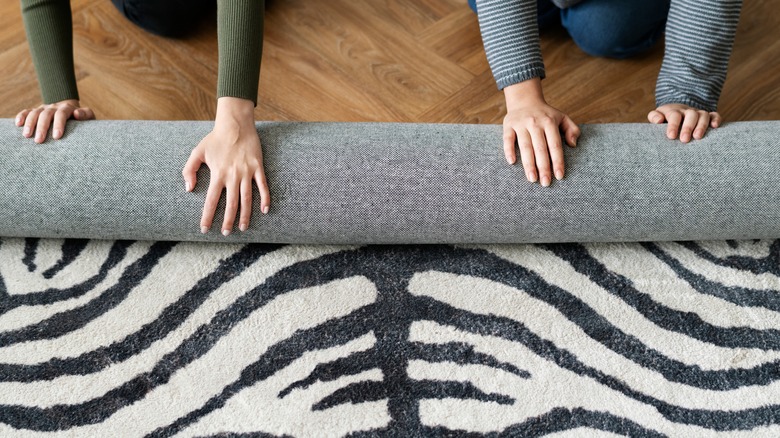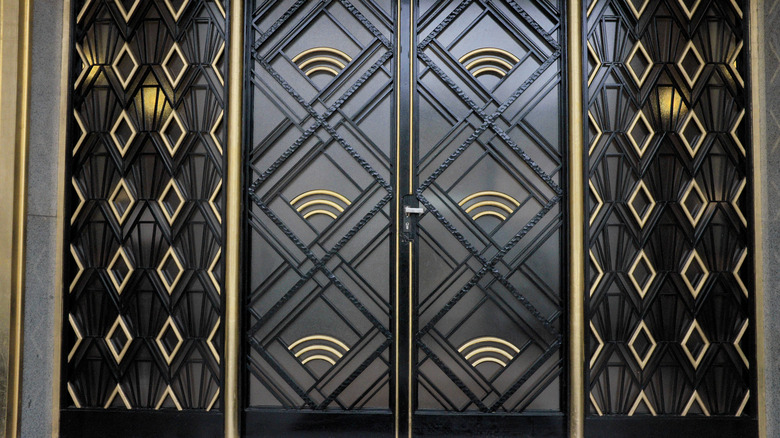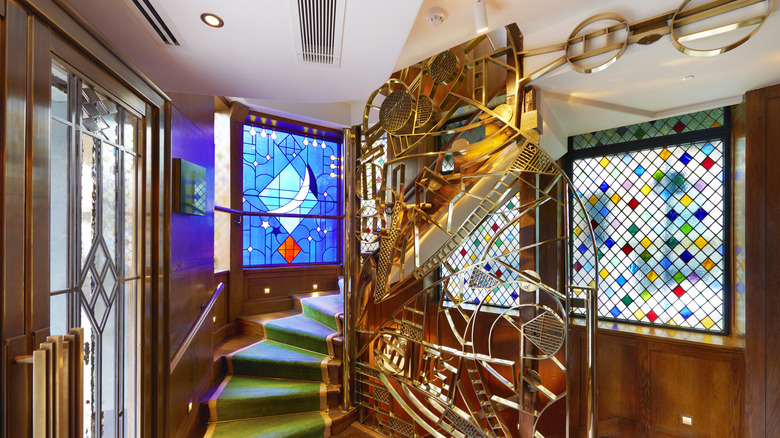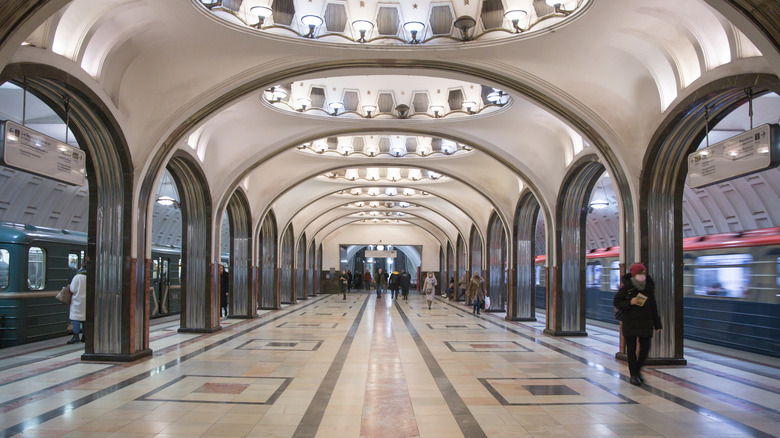The Ultimate Guide To Art Deco Decor
When most people think about the art deco movement, images of "The Great Gatsby” probably spring to mind. You might think of big parties, grand displays of wealth, lots of gold, and Delauney font. Seriously, every single party store sells all their Gatsby merchandise in Delauney font. But what is art deco, really? According to The Art Story, art deco is a direct response to the art nouveau movement. Art nouveau can be characterized by elaborate designs and expensive materials. It often had nature-inspired themes and focused on individual artisans rather than mass production.
However, after the first World War, this became less and less possible, so art deco was born. The style began in France and was popular throughout the 1920s and 1930s. It focused on bold colors, the streamlined production of the industrial age, and sleek geometric shapes, rather than the tangles of nature. The movement was actually named by its critic Le Corbusier, who first used the term to make fun of the style for being too ornate. He didn't think modern design needed any fluff and should be functional only. It wasn't until the 1960s that UK historian Bevis Hillier used the term in a positive light that the style's name was widely used.
Whether you're a Gatsby fan, or into the overall aesthetic, you can go art deco on any budget.
Be sure to include animal prints
According to Venice Clay Artists, animals and animal prints became increasingly popular in global design at the start of the 20th century. Just 100 years prior, the art nouveau movement took off, which introduced more realistic natural influences to mainstream design. Instead of the dragons and gargoyles of the Gothic era, designers started incorporating butterflies, dogs, and even elephants into their work. In fact, animal prints and motifs from Africa gained particular prominence, like elephant figurines, zebra rugs, or tiger-print pillows.
When used tastefully, animal prints are a big part of art deco design. Choosing to use animal prints in your home used to be a very bold choice (via The Luxurist). The reasoning is that, in the past, adding a zebra print rug to your living room would have likely required the killing of an actual zebra. But now, as times change, it's easier to get your hands on more authentic dupes if you prefer to be cruelty-free. Cushions and throw pillows are one of the easiest ways to incorporate art deco animal prints into a space. They add a nice pop of color and texture to otherwise-neutral rooms. In addition, consider sprinkling your rooms with other motifs, like an elephant book end or a jewelry case with a jaguar handle.
Don't be afraid to mix patterns
One of the most fun ways to embrace the art deco style when putting together your home is to consider embracing the movement's attachment to chic mismatch. According to Mansion Global, if you want to combine patterns correctly, you need to pay close attention to their textures. This means that a checkered pillow could work well with a floral bedspread if their textures contrast enough. In addition, be sure to intermix plenty of neutrals to avoid things becoming too visually overwhelming.
It also helps to have a larger idea in mind when combining patterns. That is, if you combine chevron cushions with your zebra print couch just to stay on trend, it's possible that you could quickly find yourself with an out-of-date, garishly-styled home. However, if you already own a pinstripe loveseat and find a footstool with a different pattern while thrifting, it's possible that you can piece together a look that you love. Don't be afraid to mix patterns, but on the flip side, don't get too attached to the first combination you try out, as you might need to adjust things just a little to get the perfect final look
Focus on brass accents in living spaces
According to Schlage, homeowners in the art deco era favored the warm, shiny impact that brass accents add to a room. The reasoning behind their inclusion is that the newly-rich families of this time wanted a chance to humbly brag to their family, friends, and neighbors about their wealth. While they couldn't typically pass their large bank statement around a party, they could decorate their home with the latest and greatest styles to ensure everyone knew just how much money they were sitting on.
So, they tended to use metallic accents, and a lot of them, to boot. While gold was more popular back then, brass is a great, less-expensive swap for the modern era (via Better Homes and Gardens). This swap is a bit lucky, as now people tend to just admire the visual impact of the art deco style without all the subtle bragging. You can use smaller brass accents to liven up a room, such as brass doorknobs or light switch covers. However, you can go a bit bolder and incorporate things like a brass coffee table, chairs, or even a large art piece to really shake things up.
Consider growing your personal art collection
Works of art from the art deco period are some of the most inspirational and playful on the current market. According to Christie's, because of the style's popularity, you must proceed with caution before purchasing it. Before purchasing a piece for your home, consider its current condition. Has its current owner restored the item? If so, the price point of the item might seem high, but you have to think about the work you no longer have to do. On the flipside, if the item is unrestored, or has been restored poorly, this might bring the price down.
You'll also need to consider the item's provenance, or where it came from. This is especially true for items coming out of Europe, as the Axis Powers of World War II displaced large amounts of art and other artifacts (via National Archives). If purchasing original art deco pieces isn't in your budget, there are still plenty of opportunities to purchase modern works at a variety of price points. Places like Etsy, Wayfair, and even Crate & Barrel have rotating stocks of art deco-inspired pieces.
Play with lighting by adding a fun chandelier
Lighting a room in an art deco style offers both practical and aesthetic opportunities. According to Lights Online, there was a big interest in archaeology in the 1920s and 1930s — right around the time that the art deco style was coming into fashion. Because of this, you will see a lot of influences of ancient cultures on the design. These influences are because designers saw the artifacts coming out of Greek, Egyptian and even Aztec dig sites and wanted to mimic them. Now, we tend to associate these designs with old Hollywood rather than ancient times, but the trend of mimicking former glamor remains.
There are a few different ways you can use lighting to enhance your home. If you are lighting an entertaining space, such as a living room or dining room, you might favor a wild pendant piece that hovers over the room's main point like a radical chandelier (via Fat Shack Vintage). But, when lighting more personal spaces in the home, like a bedroom or office, consider using lamps or wall sconces to achieve your desired look. This way, the lighting can be controlled on a smaller scale to accommodate just one or two people using the room.
Consider monochromatic rooms
Art deco designers loved playing with a color. So much so that the era was defined by bold color choices, like monochromatic rooms. You can consider a room to be monochromatic if there is one overarching color choice for a room. However, not everything present in the space needs to match exactly; that is, you can use different shades and hues to create a varied look. Even so, sometimes you might want to incorporate small amounts of complementary colors (or even neutral tones) to give the eyes a break.
You might do this by having a base color like white for all large elements of the room, like door frames and furniture, but each accent (linens, lampshades, wallpaper, etc.) is a hue of your color of choice. You can also incorporate visual breaks by incorporating patterns into the room, as even if they are the same color palette, the patterns appear softer to the eye.
Rely on symmetry to create order in your home
A very signature element of the art deco style is its reliance on symmetry to create sleek living spaces. According to Homes & Gardens, using symmetry creates a feeling of calm within your home, and is especially helpful when you would like a smaller space to feel larger and even a bit cleaner than normal.
The best way to anchor a room with symmetry is with an element of architecture in your home. This could be a doorway, a fireplace, or even a window. If you don't have one of these in your space that works, you can use a large statement piece as an alternative. This would be something like an area rug, a bed's headboard, or even a larger piece of art. Branching out from that, it's visually stimulating (and very art deco) to include symmetry down to the smallest details, like the number of books on the bookshelf, or pairs of shoes on the rack.
Pay attention to your flooring choices
When decorating, art deco really gives you a chance to show off your style on each part of the room — even the floors. According to Flooring Inc, it's easy enough to forget your flooring when considering the overall style of your home. After all, isn't it just something people would walk all over? However, if you ignore your flooring you are missing out on a great opportunity to further explore your art deco dreams.
Tile is a great flooring choice because it's highly durable and can match well with pretty much any decorating scheme. If you go for a classic black and gold Gatsby look, then tile is a perfect choice. And if you decide to do a monochromatic blue bedroom with brass accents? Tile also works. Another great thing about tile is that you can easily incorporate the fun geometric patterns that art deco is so famous for. You can do this by combining multiple tiles to create fun designs, or even purchasing individual tiles in funky, stylish shapes. And, if you're looking for softness, consider either wall-to-wall carpeting or area rugs in art deco-inspired patterns and colors.
Crown molding tops off any space
When you want to create an art deco space, you'll want to ensure the room looks great from the floor to the very top of the ceiling. You can easily do this by installing crown molding. According to Mouldings One, art deco designers loved using moldings as a way to add personality to a room. Art deco moldings have a few key characteristics to look out for. The first is that they are typically variations of the most popular S4S shape, but have smoother edges, plenty of curves, and nice, clean lines. S4S stands for surfaced on four sides, meaning that the wood is finished on all four areas (via Highland Woodworking).
If your home currently doesn't have crown molding, it's very easy to install to instantly elevate the look and add a touch of art deco style. You can rent the tools needed from any local hardware store and only need basic carpentry skills for a successful finish (via HGTV).
Incorporate geometric shapes for a playful feel
The style of the art deco era was defined by bold new shapes and ideas. According to Decorators Best, the introduction of unique geometric designs is directly tied to the development of the industrial world that was happening at the same time. We can see these fun shapes and strong lines in the smaller details of art deco, like jewelry boxes, all the way up to the skyscrapers of the era, such as the Chrysler building in New York City.
When selecting shapes for art deco decor, keep your eye out for a few key things. You'll want to look for bold straight lines, as well as repeating patterns of diamonds or triangles. In addition, try to include things like fan shapes, leaves, feathers, and even shell-shaped items. It's easy to incorporate these patterns into your home to give things a snappy, glamorous feel. Even if you don't purchase outright patterned items, you can still incorporate the embellishments into your home by including furniture at an angle, or period prints.
Don't be afraid to be extra glamorous
In 1922, archaeologists discovered King Tut's tomb in Egypt, and elites around the world latched on to the luxuries of his lifestyle. According to GIA, artists of the time liked to draw from old masters like Michelangelo and Rembrandt, but the tomb's discovery renewed interest in ancient cultures. So, you might see a lot of Egyptian, Greek, Roman, and even Aztec influences in art deco pieces. When drawing inspiration from the ancient world, art deco designers weren't afraid to go over the top for luxury, so you shouldn't be, either.
In addition to this, art deco contemporaries loved capturing exotic animals like jaguars and peacocks in jewelry pieces, or including stylized palm trees in rugs, wardrobe doors, and everything in between. Everything was gold, silver, chrome — some sort of reflective surface so you could always see yourself and your wealth. There was leather everywhere (via The Spruce). If you want to go over the top, go for it. Because when you style an art deco space, there really is no such thing as too much glamor.
Furnish with Art Deco woods
According to antique furniture dealers Lots 2 Like, the lavishness of the art deco era wasn't lost on its furniture, either. Highly polished wooden furniture was especially popular during this time, with the likes of Walnut, Oak, Maple, and Rosewood in high use. If you are purchasing authentic art deco furniture, you're likely to find plenty of things like extravagant dining room sets, opulent bedroom furniture, and plenty of fun extras like dressing tables and display cabinets for oddities and collections. Occasionally, you might find wooden pieces with bits of stone (like marble) as supporting elements, such as basins.
Whether you are purchasing pieces of authentic art deco furniture, or more modern furniture made in its style, you'll also want to look for wooden pieces that play with other elements of the era, like its obsession with metallic chrome, geometric shapes, and glamor (via The Inside).
Try high-contrast colors
The 1920s and 30s were known for bold opinions and bolder colors. According to Better Homes and Gardens, the deep woods that were popular in the period, like ebony and zebrawood, lead to a very defined color palette. The same can be said of the reflective, metallic surfaces that were also popular during this time. In addition, designers of the era also showed affinity for deep basics. This means that if they used black, they used the darkest, purest shade they could find. The same goes for white — it had to be absolutely stark. And you would be hard-pressed to find a beige more creamy and welcoming. To really get the look, try mixing these colors together in high-contrast combinations.
If you want to add richer colors to the mix, you might also try a few period favorites like canary yellow (sometimes called marigold), emerald green, peacock blue (also known as royal blue), and deep, velvety purples and reds.
Use arches for a sleek look
According to Lines Mag, arches have always been a consistent element in most architectural trends, dating as far back as the Romans. They are stylish and they work well, so it makes sense that they're an evergreen favorite among designers. However, the round-top shape was a particular staple in the art deco era's designs. This is because most rooms are rectangles; they have straight lines throughout, so by adding an arch, you can add a touch of glamor and interest. Both of the features were hallmarks of the style.
Arches also help to better define rooms. If you have a regular rectangular passageway between your living room and dining room, the two spaces might feel like one large room without defined characteristics. So, to add to any separation you might attempt to achieve with furniture and other decorations, rounding the corners of the open space in between automatically adds character to each area. In addition to using arches for living spaces, consider them in other elements of the room, like headboards for your bed, and even mirrors.














